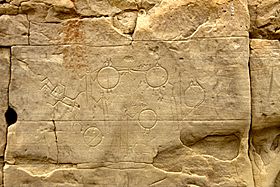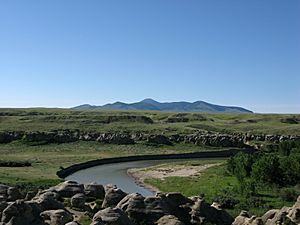Writing-on-Stone Provincial Park facts for kids
Quick facts for kids Writing-on-Stone Provincial Park |
|
|---|---|
| Native name Blackfoot: Áísínaiʼpi |
|

These petroglyphs were created prior to the arrival of the horse. It shows warriors carrying body shields.
|
|
| Location | County of Warner No. 5, Alberta, Canada |
| Area | 1,106 ha 1,047 ha buffer zone |
| Founded | January 8, 1957 |
| Governing body | Alberta Environment and Parks |
| Official name: Writing-on-Stone / Áísínai’pi | |
| Criteria | Cultural: (iii) |
| Designated | 2019 (43rd session) |
| Reference no. | 1597 |
| State Party | |
| Region | North America |
| Official name: Áísínaiʼpi National Historic Site of Canada | |
| Designated | March 2005 |
| Official name: Writing-on-Stone, Glyphs | |
| Type | Provincial historic resource |
| Designated | 1981 |
| Reference no. | 4665-0060 |
|
IUCN Category III (Natural Monument)
|
|
| Designated | 1977 |
| Lua error in Module:Location_map at line 420: attempt to index field 'wikibase' (a nil value). | |
Writing-on-Stone Provincial Park is a special place in Alberta, Canada. It is located about 100 kilometers (62 miles) southeast of Lethbridge. This park protects a large area of prairie land. It is also home to many ancient rock carvings and paintings made by First Nations people.
The park is very important to the Blackfoot and other Indigenous tribes. They consider it a sacred place. In 2019, Writing-on-Stone / Áísínai’pi became a UNESCO World Heritage Site. Its Blackfoot name, Áísínaiʼpi, means "it is pictured / written." The park is also known as the Áísínaiʼpi National Historic Site of Canada.
Contents
Discovering Ancient Art and History
Writing-on-Stone Park holds the largest collection of rock art on the North American Great Plains. There are over 50 sites with thousands of carvings and paintings. These artworks tell stories about the lives of the people who lived here long ago.
What to See and Do
The park has a visitor center where you can learn more. You can also find campgrounds, picnic spots, and hiking trails. The Milk River runs through the park, perfect for canoeing and kayaking. You can also see a rebuilt North-West Mounted Police (NWMP) outpost. This building stands where the original one was, which burned down in 1918.
Plants and Animals of the Park

The park covers about 17.8 square kilometers (6.9 square miles) of coulees (small valleys) and prairie land. This diverse habitat is home to many different plants and animals.
Amazing Birds
Many types of Birds live here. You might spot prairie falcons, great horned owls, and American kestrels. Look for cliff swallows building their nests. You might also see ring-necked pheasants and grey partridges.
Mammals and More
The open prairie around the park is great for pronghorn antelopes. Other animals you might see include mule deer, skunks, raccoons, and bobcats. The park is also home to northern pocket gophers and yellow-bellied marmots.
Amphibians and Reptiles
You can find several amphibians like tiger salamanders, boreal chorus frogs, and leopard frogs. Reptiles in the park include garter snakes, bull snakes, and prairie rattlesnakes.
Unique Plants
The coulees are perfect for balsam poplars and narrow leaf cottonwoods. You'll also find peachleaf willows and plains cottonwoods. Shrubs like chokecherry, juniper, and saskatoon grow here. Even some types of cactus, like Opuntia (prickly pear) and Pediocactus (pincushion), can be found in the park.
How the Park's Landscape Was Formed
The sandstone rocks in the park are part of the Milk River Formation. These rocks formed about 84 million years ago from sand at the edge of a large ancient sea. Later, as the last glaciers melted, their water carved the Milk River valley. Over time, water, ice, and wind shaped the sandstone into the amazing hoodoos and cliffs you see today.
A Journey Through Time: History of Writing-on-Stone
People have lived in the Milk River Valley for as long as 9,000 years. First Nations tribes, especially the Blackfoot, created many of the rock carvings (petroglyphs) and paintings (pictographs). Other groups, like the Shoshone, also traveled through the valley and may have added to the art. These artworks share stories of their lives and spiritual beliefs.
Sacred Lands and Nomadic Life
The tall cliffs and hoodoos were very important to the Indigenous visitors. They believed these formations were home to powerful spirits. The sheltered coulees, along with plenty of game and berries, made this area a great stopping point for nomadic people during their seasonal travels. While most people visited temporarily, there is some evidence, like tipi rings and a medicine wheel, that some people lived here permanently.
Changes with New Arrivals
Around 1730, horses, metal tools, and guns started to appear on the western plains. This changed the way First Nations people lived. It also changed their rock art. You can see newer pictures of hunters on horseback and warriors without body shields.
The North-West Mounted Police Outpost
In 1887, a North-West Mounted Police (NWMP) camp was set up at Writing-on-Stone. The NWMP were the first version of today's Royal Canadian Mounted Police. Their main job here was to stop people from bringing illegal goods across the border. They also worked to prevent horse-raiding parties. However, these problems were not very serious at this outpost. The officers often spent their time fighting grass fires, returning lost cattle, and patrolling the quiet border.
As settlers began to arrive before World War I, the officers had more to do. In 1918, the outpost closed because Canadian authorities felt there was little crime along the border. Soon after, the outpost was destroyed by fire.
Protecting the Park's Heritage
Writing-on-Stone Provincial Park was officially created in 1957. In 1977, it became an archaeological preserve to protect its ancient art. The NWMP outpost was rebuilt between 1973 and 1975 and is now a popular attraction.
In 1981, part of the park was named a Provincial Historic Resource. This was done to protect the rock art from damage and graffiti. Today, the most sensitive areas can only be visited with a guided tour. In 2005, the park was named a National Historic Site. A new visitor center, with great views of the valley, opened in 2007.


